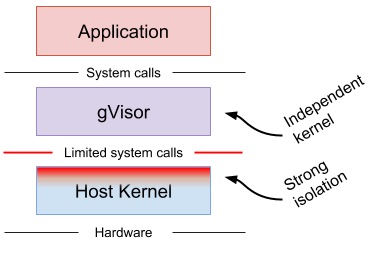概述
我认为容器标准化可以分为两个角度去讲:
一个是容器的使用和镜像的格式需要规范,这叫做OCI(open container initiative),也就是说,不同技术实现的容器,都可以使用同一种方式运行,同一个镜像也可以在不同的容器技术上运行。
另外一个就是因为Kubernetes的流行,Kubernetes推出了一个CRI(container runtime interface)的接口规范,凡是直接或间接实现了这个接口规范的容器都可以作为Kubernetes的默认容器运行时。
OCI和CRI的制定也意味着容器技术迎来了高速发展。
CRI: container runtime interface
CRI是kubernetes推出的容器运行时接口,有了CRI,不论各种容器化技术是如何实现的,都可以用一个共同的接口对外提供服务。CRI中定义了容器和镜像的接口的接口,基于gRPC调用。具体的可以查看api.proto。下面简单的列一下:
// Runtime service defines the public APIs for remote container runtimes
service RuntimeService {
// Version returns the runtime name, runtime version, and runtime API version.
rpc Version(VersionRequest) returns (VersionResponse) {}
// RunPodSandbox creates and starts a pod-level sandbox. Runtimes must ensure
// the sandbox is in the ready state on success.
rpc RunPodSandbox(RunPodSandboxRequest) returns (RunPodSandboxResponse) {}
// StopPodSandbox stops any running process that is part of the sandbox and
// reclaims network resources (e.g., IP addresses) allocated to the sandbox.
// If there are any running containers in the sandbox, they must be forcibly
// terminated.
// This call is idempotent, and must not return an error if all relevant
// resources have already been reclaimed. kubelet will call StopPodSandbox
// at least once before calling RemovePodSandbox. It will also attempt to
// reclaim resources eagerly, as soon as a sandbox is not needed. Hence,
// multiple StopPodSandbox calls are expected.
rpc StopPodSandbox(StopPodSandboxRequest) returns (StopPodSandboxResponse) {}
// RemovePodSandbox removes the sandbox. If there are any running containers
// in the sandbox, they must be forcibly terminated and removed.
// This call is idempotent, and must not return an error if the sandbox has
// already been removed.
rpc RemovePodSandbox(RemovePodSandboxRequest) returns (RemovePodSandboxResponse) {}
// PodSandboxStatus returns the status of the PodSandbox. If the PodSandbox is not
// present, returns an error.
rpc PodSandboxStatus(PodSandboxStatusRequest) returns (PodSandboxStatusResponse) {}
// ListPodSandbox returns a list of PodSandboxes.
rpc ListPodSandbox(ListPodSandboxRequest) returns (ListPodSandboxResponse) {}
// CreateContainer creates a new container in specified PodSandbox
rpc CreateContainer(CreateContainerRequest) returns (CreateContainerResponse) {}
// StartContainer starts the container.
rpc StartContainer(StartContainerRequest) returns (StartContainerResponse) {}
// StopContainer stops a running container with a grace period (i.e., timeout).
// This call is idempotent, and must not return an error if the container has
// already been stopped.
// TODO: what must the runtime do after the grace period is reached?
rpc StopContainer(StopContainerRequest) returns (StopContainerResponse) {}
// RemoveContainer removes the container. If the container is running, the
// container must be forcibly removed.
// This call is idempotent, and must not return an error if the container has
// already been removed.
rpc RemoveContainer(RemoveContainerRequest) returns (RemoveContainerResponse) {}
// ListContainers lists all containers by filters.
rpc ListContainers(ListContainersRequest) returns (ListContainersResponse) {}
// ContainerStatus returns status of the container. If the container is not
// present, returns an error.
rpc ContainerStatus(ContainerStatusRequest) returns (ContainerStatusResponse) {}
// UpdateContainerResources updates ContainerConfig of the container.
rpc UpdateContainerResources(UpdateContainerResourcesRequest) returns (UpdateContainerResourcesResponse) {}
// ReopenContainerLog asks runtime to reopen the stdout/stderr log file
// for the container. This is often called after the log file has been
// rotated. If the container is not running, container runtime can choose
// to either create a new log file and return nil, or return an error.
// Once it returns error, new container log file MUST NOT be created.
rpc ReopenContainerLog(ReopenContainerLogRequest) returns (ReopenContainerLogResponse) {}
// ExecSync runs a command in a container synchronously.
rpc ExecSync(ExecSyncRequest) returns (ExecSyncResponse) {}
// Exec prepares a streaming endpoint to execute a command in the container.
rpc Exec(ExecRequest) returns (ExecResponse) {}
// Attach prepares a streaming endpoint to attach to a running container.
rpc Attach(AttachRequest) returns (AttachResponse) {}
// PortForward prepares a streaming endpoint to forward ports from a PodSandbox.
rpc PortForward(PortForwardRequest) returns (PortForwardResponse) {}
// ContainerStats returns stats of the container. If the container does not
// exist, the call returns an error.
rpc ContainerStats(ContainerStatsRequest) returns (ContainerStatsResponse) {}
// ListContainerStats returns stats of all running containers.
rpc ListContainerStats(ListContainerStatsRequest) returns (ListContainerStatsResponse) {}
// UpdateRuntimeConfig updates the runtime configuration based on the given request.
rpc UpdateRuntimeConfig(UpdateRuntimeConfigRequest) returns (UpdateRuntimeConfigResponse) {}
// Status returns the status of the runtime.
rpc Status(StatusRequest) returns (StatusResponse) {}
}
// ImageService defines the public APIs for managing images.
service ImageService {
// ListImages lists existing images.
rpc ListImages(ListImagesRequest) returns (ListImagesResponse) {}
// ImageStatus returns the status of the image. If the image is not
// present, returns a response with ImageStatusResponse.Image set to
// nil.
rpc ImageStatus(ImageStatusRequest) returns (ImageStatusResponse) {}
// PullImage pulls an image with authentication config.
rpc PullImage(PullImageRequest) returns (PullImageResponse) {}
// RemoveImage removes the image.
// This call is idempotent, and must not return an error if the image has
// already been removed.
rpc RemoveImage(RemoveImageRequest) returns (RemoveImageResponse) {}
// ImageFSInfo returns information of the filesystem that is used to store images.
rpc ImageFsInfo(ImageFsInfoRequest) returns (ImageFsInfoResponse) {}
}
共包含了两个服务:
– RuntimeService:容器和Sandbox运行时管理。
– ImageService:提供了从镜像仓库拉取、查看、和移除镜像的RPC。
再看一下CRI的架构图:

在kubernetes中,CRI扮演了kubelet和container runtime的通信桥梁。也因为CRI的存在,container runtime和kubelet解耦,就有了多种选择,比如: docker、 CRI-O、containerd、frakti等等。
OCI: open container initiative
这个是由docker和其他的公司推动的容器标准,为了围绕容器格式和运行时制定一个开放的工业化标准,目前主要有两个标准文档:容器运行时标准 (runtime spec)和 容器镜像标准(image spec)。这两个协议通过 OCI runtime filesytem bundle 的标准格式连接在一起,OCI 镜像可以通过工具转换成 bundle,然后 OCI 容器引擎能够识别这个 bundle 来运行容器

下面引用一下其他博客的文字(https://www.jianshu.com/p/62e71584d1cb):
设计考量
操作标准化:容器的标准化操作包括使用标准容器创建、启动、停止容器,使用标准文件系统工具复制和创建容器快照,使用标准化网络工具进行下载和上传。
内容无关:内容无关指不管针对的具体容器内容是什么,容器标准操作执行后都能产生同样的效果。如容器可以用同样的方式上传、启动,不管是PHP应用还是MySQL数据库服务。
基础设施无关:无论是个人的笔记本电脑还是AWS S3,亦或是OpenStack,或者其它基础设施,都应该对支持容器的各项操作。
为自动化量身定制:制定容器统一标准,是的操作内容无关化、平台无关化的根本目的之一,就是为了可以使容器操作全平台自动化。工业级交付:制定容器标准一大目标,就是使软件分发可以达到工业级交付成为现实
image spec(容器标准包)
OCI 容器镜像主要包括几块内容:
文件系统:以 layer 保存的文件系统,每个 layer 保存了和上层之间变化的部分,layer 应该保存哪些文件,怎么表示增加、修改和删除的文件等
config 文件:保存了文件系统的层级信息(每个层级的 hash 值,以及历史信息),以及容器运行时需要的一些信息(比如环境变量、工作目录、命令参数、mount 列表),指定了镜像在某个特定平台和系统的配置。比较接近我们使用 docker inspect
看到的内容 manifest 文件:镜像的 config 文件索引,有哪些 layer,额外的 annotation 信息,manifest 文件中保存了很多和当前平台有关的信息
index 文件:可选的文件,指向不同平台的 manifest 文件,这个文件能保证一个镜像可以跨平台使用,每个平台拥有不同的 manifest 文件,使用 index 作为索引
runtime spec(容器运行时和生命周期)
容器标准格式也要求容器把自身运行时的状态持久化到磁盘中,这样便于外部的其它工具对此信息使用和演绎。该运行时状态以JSON格式编码存储。推荐把运行时状态的JSON文件存储在临时文件系统中以便系统重启后会自动移除。
基于Linux内核的操作系统,该信息应该统一地存储在/run/opencontainer/containers目录,该目录结构下以容器ID命名的文件夹(/run/opencontainer/containers/
/state.json)中存放容器的状态信息并实时更新。有了这样默认的容器状态信息存储位置以后,外部的应用程序就可以在系统上简便地找到所有运行着的容器了。 state.json文件中包含的具体信息需要有:
版本信息:存放OCI标准的具体版本号。
容器ID:通常是一个哈希值,也可以是一个易读的字符串。在state.json文件中加入容器ID是为了便于之前提到的运行时hooks只需载入state.json就- – 可以定位到容器,然后检测state.json,发现文件不见了就认为容器关停,再执行相应预定义的脚本操作。
PID:容器中运行的首个进程在宿主机上的进程号。
容器文件目录:存放容器rootfs及相应配置的目录。外部程序只需读取state.json就可以定位到宿主机上的容器文件目录。
容器创建:创建包括文件系统、namespaces、cgroups、用户权限在内的各项内容。
容器进程的启动:运行容器进程,进程的可执行文件定义在的config.json中,args项。
容器暂停:容器实际上作为进程可以被外部程序关停(kill),然后容器标准规范应该包含对容器暂停信号的捕获,并做相应资源回收的处理,避免孤儿进程的出现。
CRI和OCI的对比
OCI是容器技术的开放性标准,而CRI是Kubernetes为了更方便的支持不同的容器技术,而推出的接口标准,与CRI类似的还有CNI和CSI,分别是网络和存储的接口。
可以看一下这张图:
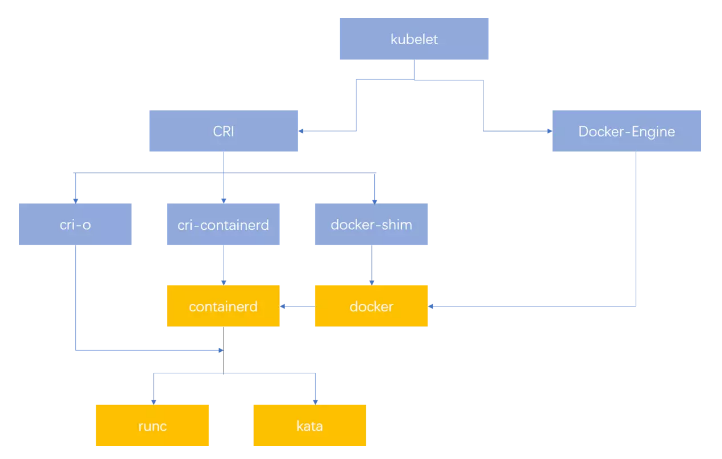
kubelet有了CRI的接口,可以通过cri-containerd和containerd通信,也可以通过docker-shim和docker通信。注意这里的cri-containerd在containerd v1.2的时候就已经不再使用了,因为containerd本身就支持了CRI的规范。
同时kubernetes还孵化了cri-o这个项目,cri-o直接打通了cri和oci。runc和kata都是oci的具体实现。
所以,用一句话理解:实现了CRI就可以保证被kubernetes使用,实现了OCI就可以在各种设备上无差别的使用各种镜像。
docker、containerd和runc
containerd从docker中分出来的一部分。containerd是负责管理容器生命周期的常驻进程,而runc则是真正负责容器运行的部分。可以通过以下的图来看三者之间的关系:
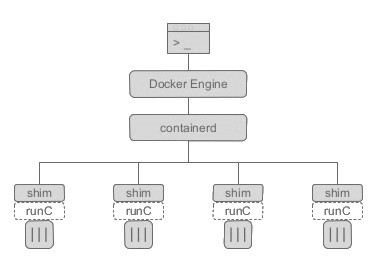
containerd会调用多个runc实例来管理多个容器。docker engine则是提供接口给用户使用。
kubernetes当前支持的CRI后端
containerd
containerd的地址:https://github.com/containerd/containerd
先用官网的图片来看一下containerd的架构:
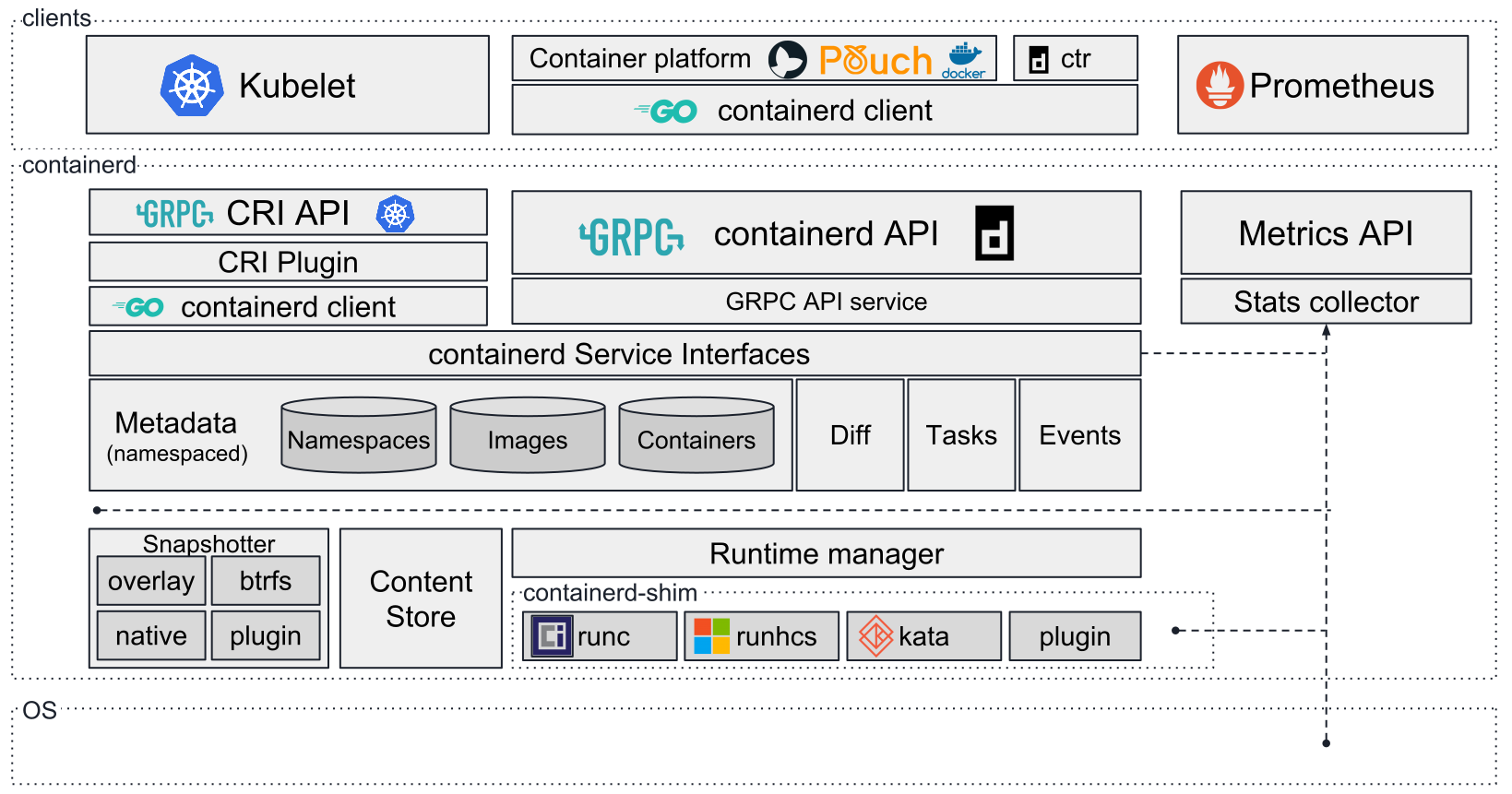
containerd处于os和clients之间,它使用CRI API提供给Kubelet调用,使用containerd API提供给containerd client调用,使用Metrics API提供给Prometheus监控数据。然后有一层containerd Service Interfaces提供给上层api使用。注意到其中还有一个container-shim打通了Runtime manager和OCI runtime的具体实现,比如runc、runhcs、kata。
containerd实现了以下的特性:
- OCI Image规范的支持
- OCI Runtime规范的支持(通过runc等)
- Image的上传和下载
- 容器运行时和生命周期的支持
- 创建、修改和删除网络
- 管理网络命名空间以及将容器加入到现有的网络命名空间
- 全部镜像的CAS存储的多租户模式支持
cri-o
项目地址:https://github.com/cri-o/cri-o
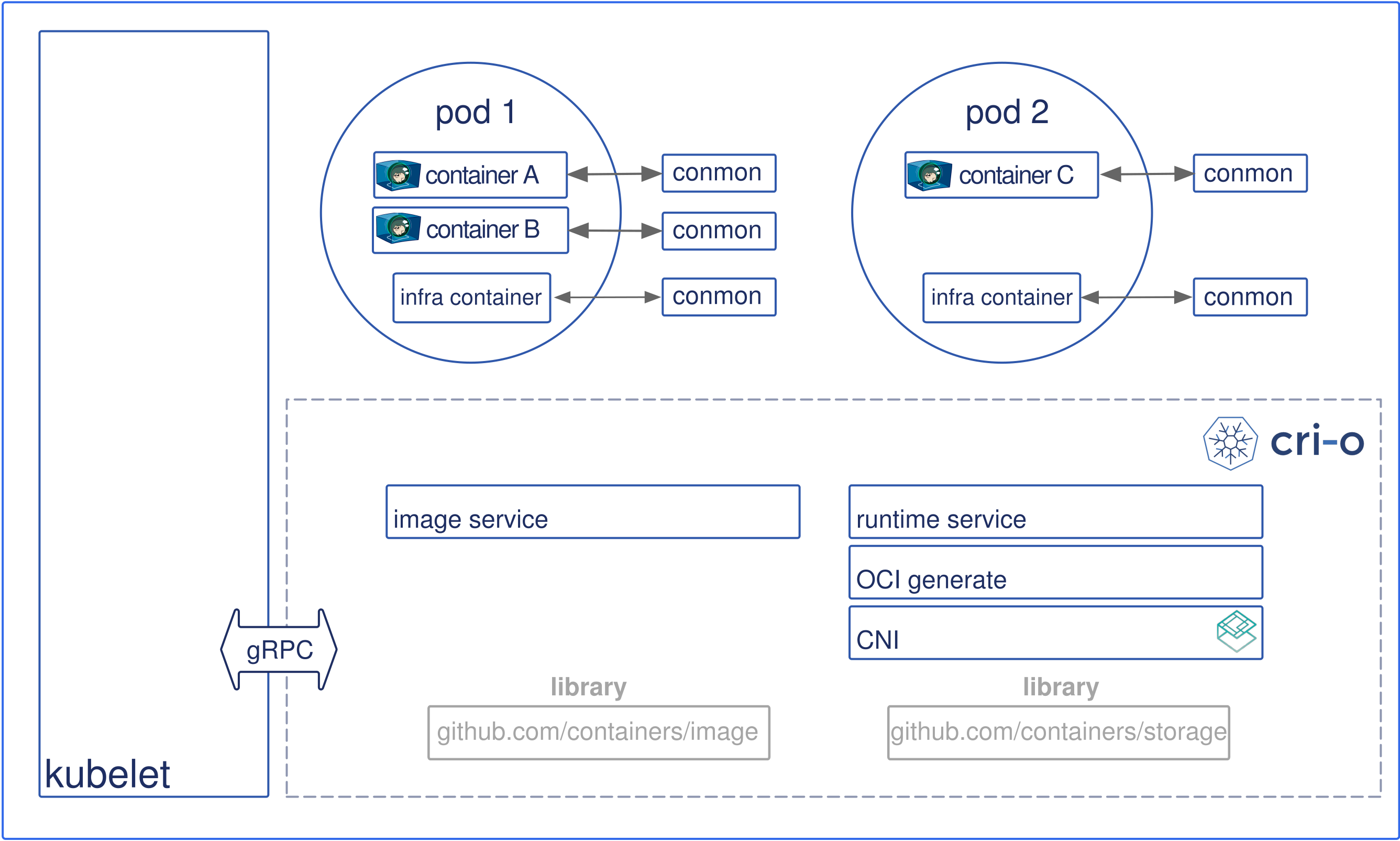
cri-o项目是Kubernetes CRI接口的实现,同时可以兼容OCI标准的容器运行时。这样的能力就使得它可以作为Docker的轻量级的容器运行时的替代方案,使得Kubernetes可以接入符合OCI标准的所有容器运行时,同时也减少了容器开发者们的额外工作量(只需实现OCI标准即可)。
frakti
项目地址:https://github.com/kubernetes/frakti
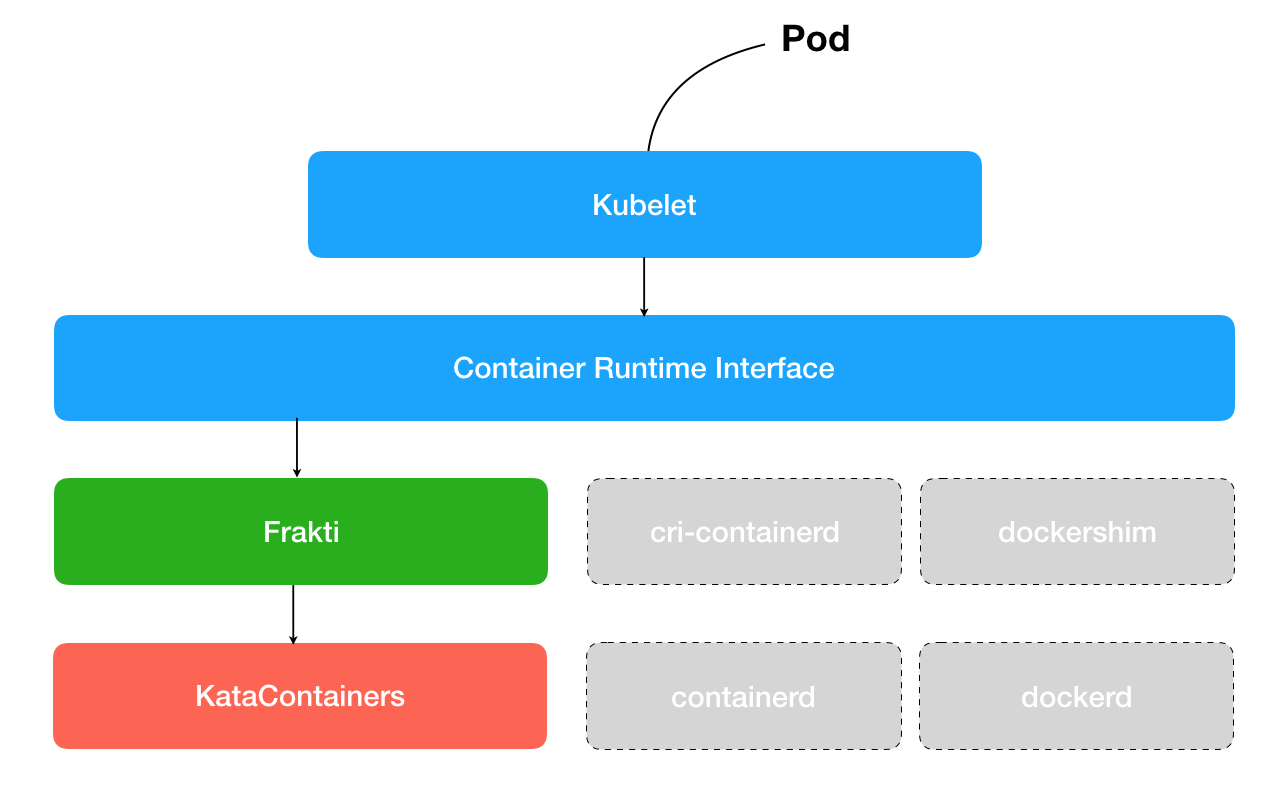
frakti是Kubernetes官方推出的一个容器运行时,但是不同于docker这样的利于linux namespace的技术,它是基于虚拟化技术的容器,因此可以带来更好的环境隔离以及独享的内核。
rkt
项目地址:https://github.com/rkt/rkt/
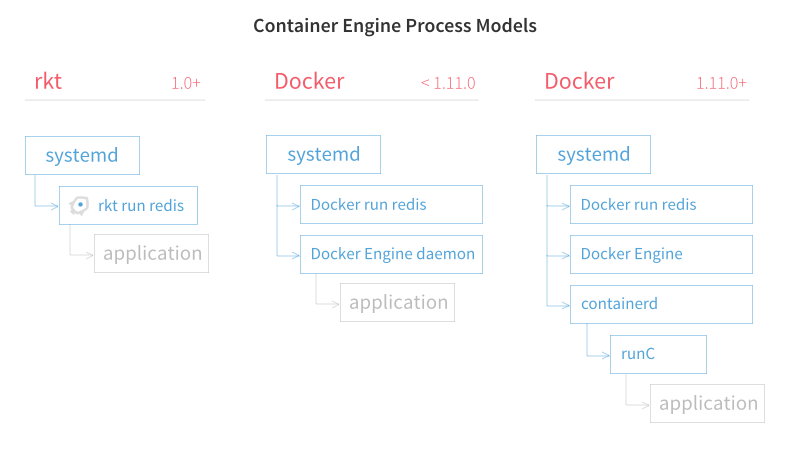
rkt是coreos推出的和Docker抗衡的容器产品,不同于现在的Docker往更大更全的方向,不仅仅是容器功能,更集成了Swarm这样的集群方案,rkt注重的是作为运行在linux系统上的容器组件。上图可以看出Docker的架构要更加的复杂。
docker
官网地址: https://docker.com
docker作为Kubernetes的默认容器运行时,其本身在容器领域也占据了绝对的领导地位。
实现了OCI,可以通过cri-o接入kubernetes的项目
runc
项目地址: https://github.com/opencontainers/runc
opencontainers组织推出了OCI的规范,同时也开发了runc作为OCI规范的实现。runc是docker贡献出来的容器运行时,runc不仅是containerd的默认运行时,同时也可以接入到cri-o中。
Clear Containers
https://github.com/clearcontainers/runtime,项目已经不在维护,推荐迁移到Kata Containers
Kata Containers
https://github.com/kata-containers/runtime
Kata Containers和runc这种技术栈是不同的。runc使用的是linux namespace和cgroup来做环境隔离和资源限制,缺点在于使用的仍然是宿主机的内核,这样一旦受到了内核层的影响,会扩散到所有的容器。而Kata Containers使用的是虚拟化的技术,它实际上是一个虚拟机,但是可以像容器那样使用。
Kata Containers是2017年12月启动的项目,结合了Intel Clear Containers和 Hyper.sh RunV的优点,支持不同的主流架构,除x86_64外,还支持AMD64, ARM, IBM p-series and IBM z-series。
下图是kata Containers和传统容器技术的对比:
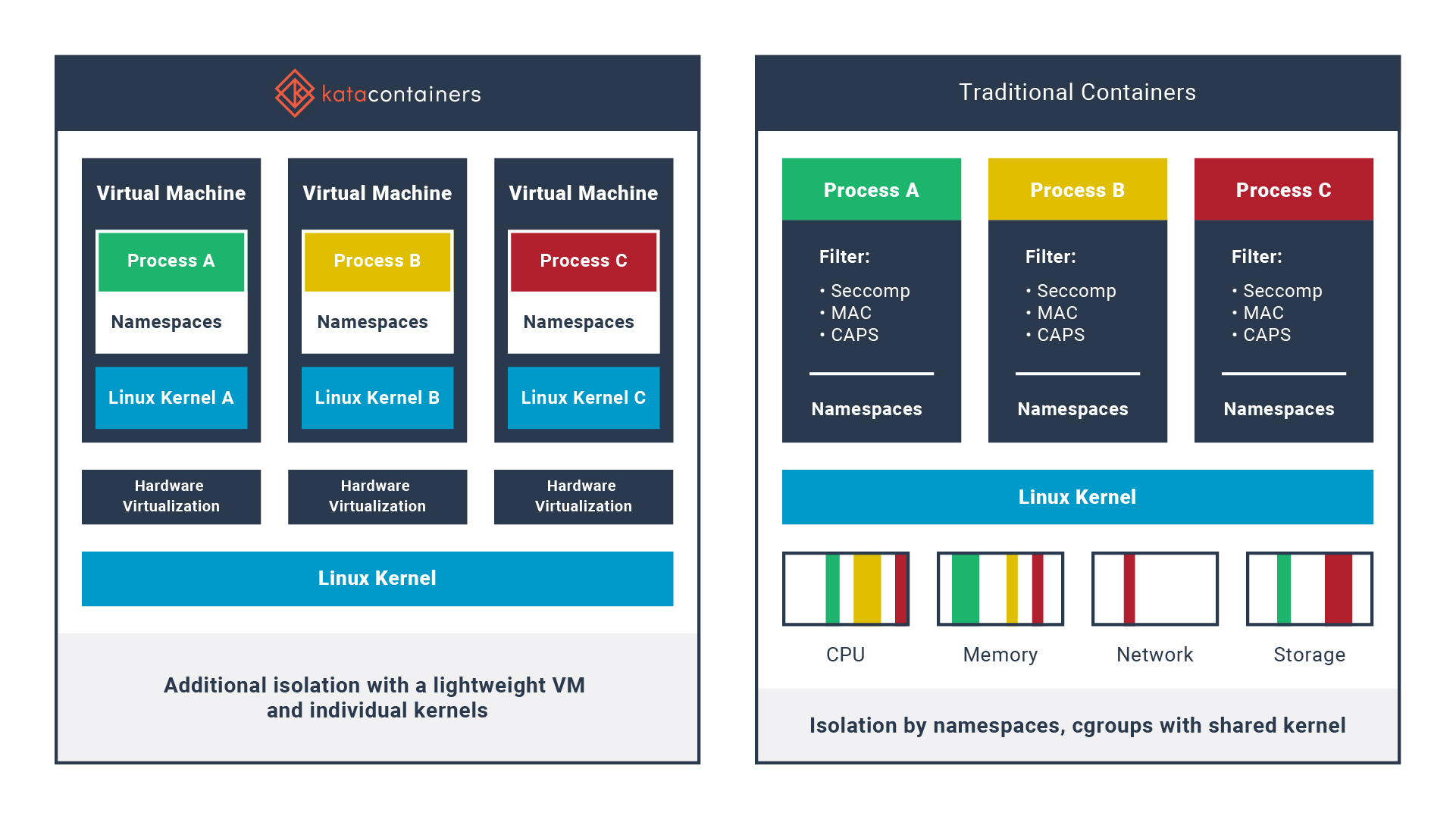
主要特点如下:
- 安全性: 使用专用内核,提供了网络、IO和内存的独立,在虚拟化VT扩展的基础上利用硬件强制隔离
- 性能: 提供与标准Linux容器一致的性能;提高隔离度,而无需增加标准虚拟机的性能。
- 兼容性: 支持行业标准,包括OCI容器格式,Kubernetes CRI接口以及旧版虚拟化技术。
- 简单: 消除了在完整的虚拟机内部嵌套容器的要求;标准接口使插入和入门变得容易
下图是Kata Containers的架构:
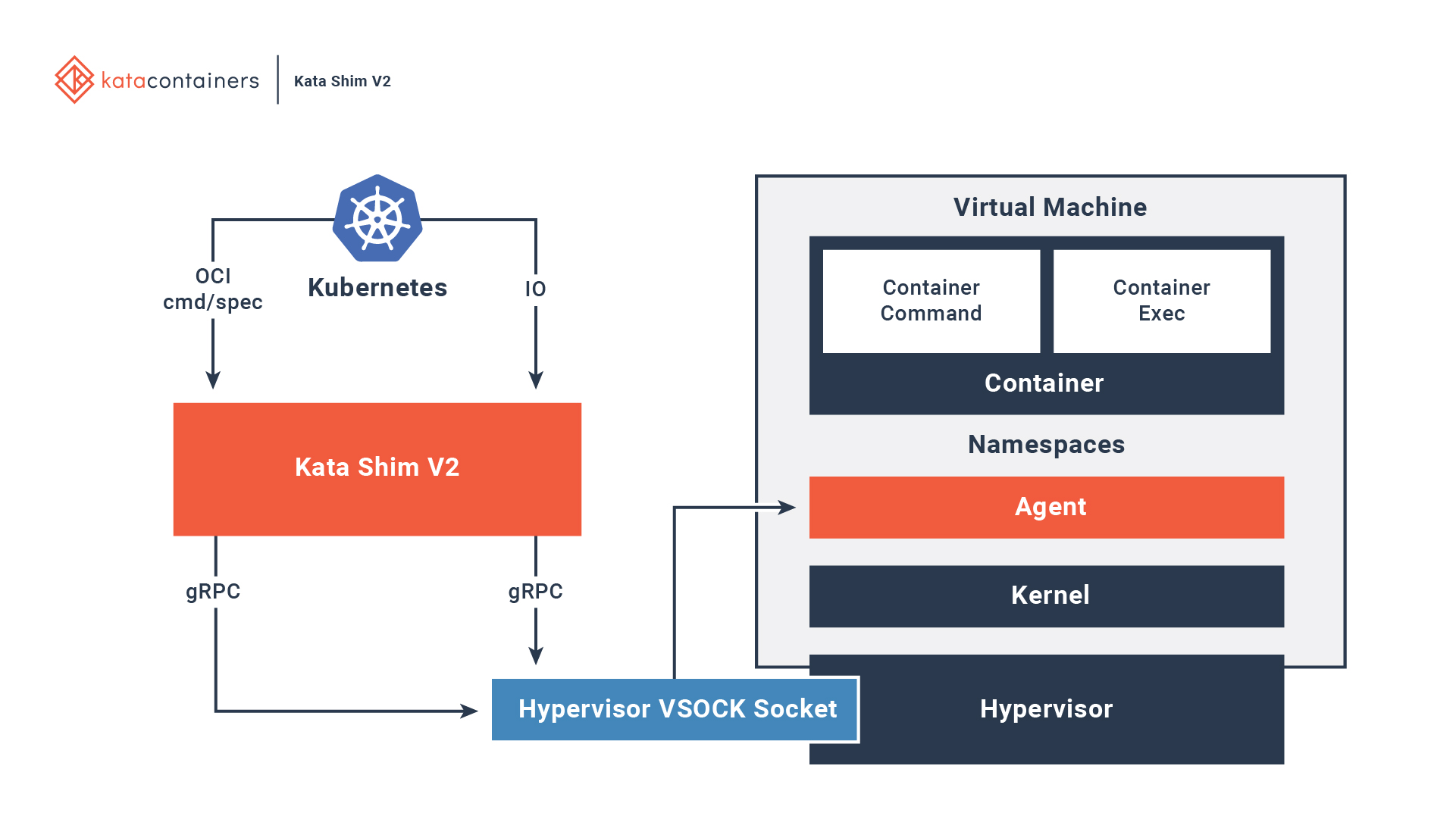
Kubernetes可以通过Hypervisor VSOCK Socket和容器交互。
gVisor
gVisor提供的是一个沙箱容器环境,可以说是传统容器技术和虚拟机容器技术的折中。它使用Go编写了一个可以作为普通非特权进程运行的内核,这个内核实现了大多数的系统调用。所以相比于namespace和cgroup实现的容器,它可以屏蔽掉容器内应用程序的内核调用。相比于虚拟机实现的容器,它更轻量级(作为系统的一个进程运行)。
